Three steps to taste coffee-smell, taste and aftertaste
Professional coffee knowledge exchange more coffee bean information please follow the coffee workshop (Wechat official account cafe_style)
I believe that many enthusiasts will encounter such a situation. I buy a bag of beans with citrus and peach flavor, but I can't taste them, so I suspect it's the beans, the cooking, or the senses.
The flavor of coffee bothers many students. How can I not drink so many flavors on the flavor table? ~ after all, not everyone has professional feelings, or I drink not peach flavor, but plum flavor. The reason for this difference is the different regions of cultural life and diet, different descriptions of the same cup of coffee, so coffee taste, the most important thing is communication. Talk about how you feel about this bean, experience is different, description must be different, but this kind of communication can bring a lot of fun, isn't it?
To give a simple example of the above SCAA flavor wheel, the chocolate aroma reflected in Mena's reaction, such as milk chocolate, dark chocolate and white chocolate, which enthusiast can really tell the difference between these three chocolate flavors without special training or high level of taste (now even chocolate has a flavor wheel, )
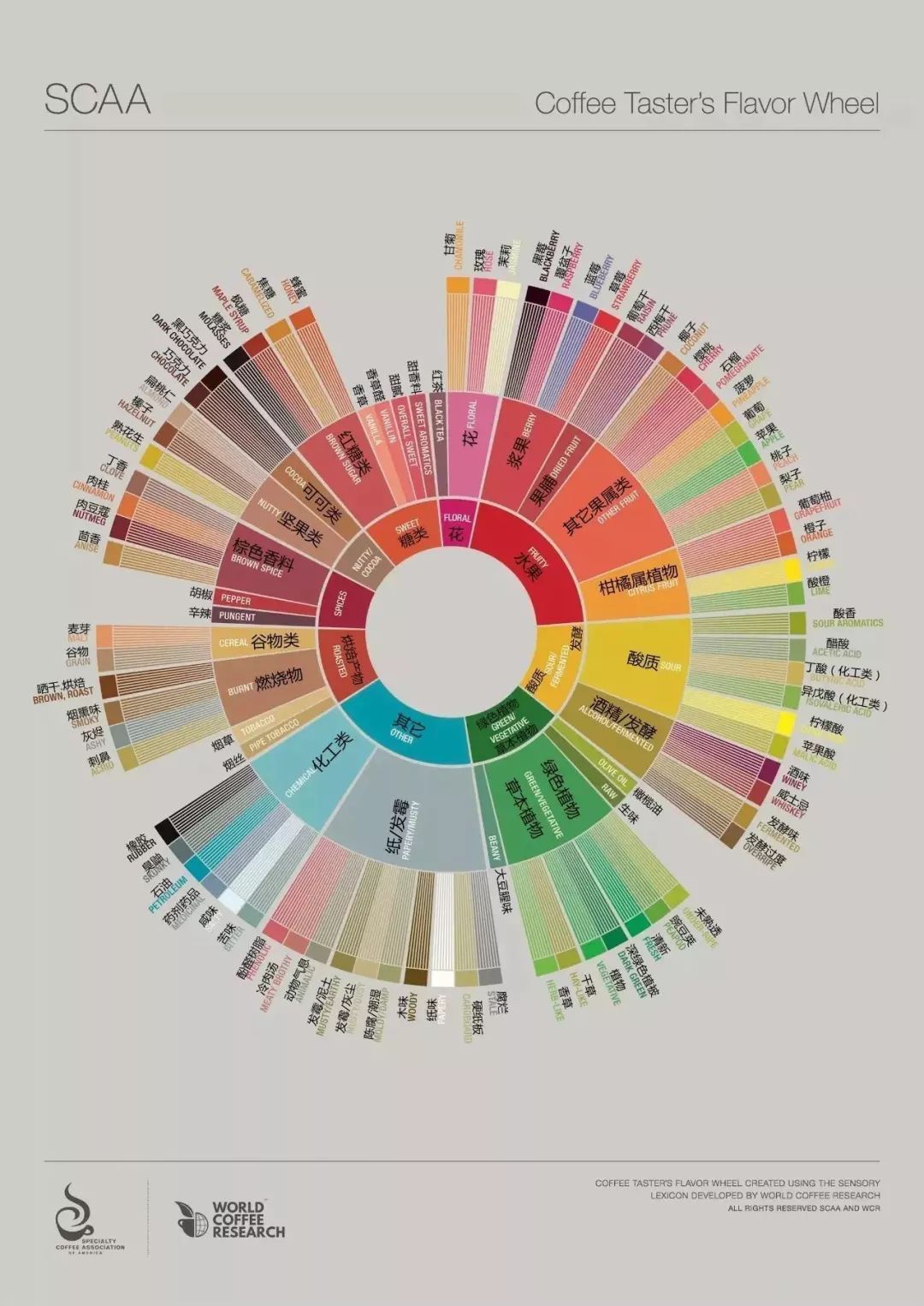
To understand coffee, you need three conditions:
The first one: have you ever experienced a similar sense of taste and smell? if you haven't eaten peaches, of course you can't taste peaches. Coffee tasting | the importance of tasting coffee sensory training-sense of smell
The second: it is recommended that you wait until the coffee is completely cold before tasting it, because usually the fruit tonality of the coffee will not be recognized until it is cold, and the coffee flavor will unfold as the temperature drops. Coffee tasting | how to identify the lemon, grapefruit and honey in the coffee?
Third: the intensity of coffee can also affect the tonality of a cup of coffee. If it is a lightly roasted coffee with floral flavor, it is recommended to dilute it and open the taste spectrum so that it is easy to find the taste in it (this is a good explanation for why the ratio of powder to water measured in the cup is 1buzz 18.18). Coffee tasting | can you tell the fragrance of flowers in the coffee?
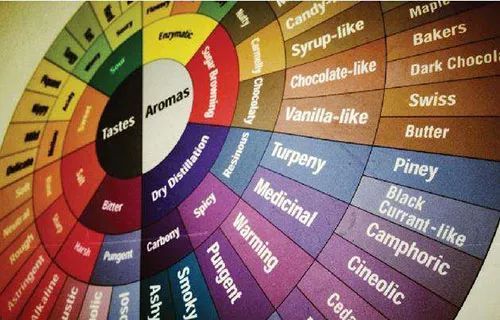
For example, to taste a good cup of Yega coffee, the steps:
Drink coffee with a small sip, drink slowly, or even gargle and gently stir the coffee liquid in your mouth.
Each mouthful will expand with the change of temperature, and the roots of the first two tongues will be bitter. When the coffee temperature is cold, it will slowly change from bitter to sour, subtle citrus acid.
In the middle of the drink, the coffee changes from sour to sweet, from bitter to sweet, begins to taste sweet, has a sweet taste on the tongue, and finally has a sweet aftertaste to caramel, staying between the mouth and nose, tasting the aftertaste of coffee through the sense of smell behind the nose.
Do not rush to wash the cup after drinking, to smell the sweetness of the bottom of the cup.
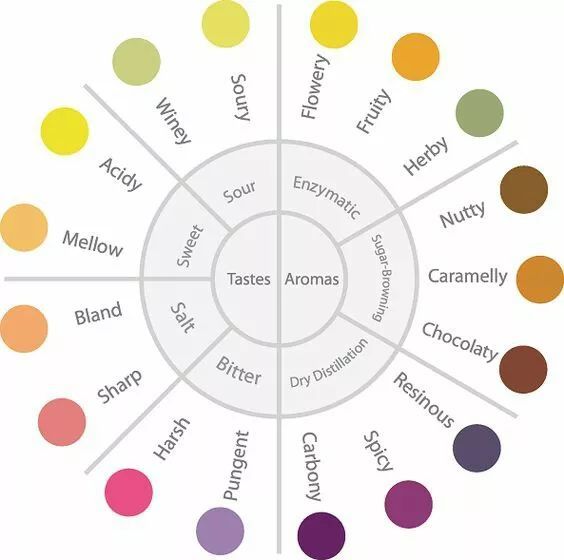
The brain receives information-"compare-analyze -" memory (the whole process)
We can smell a smell, taste a taste, but maybe we can't describe it very accurately. The flavor wheel can classify all the taste systems perceived by human beings, corresponding to the smell system is the smell wheel, with the practice of the two, we can clearly sense the slightest difference among all the odors.
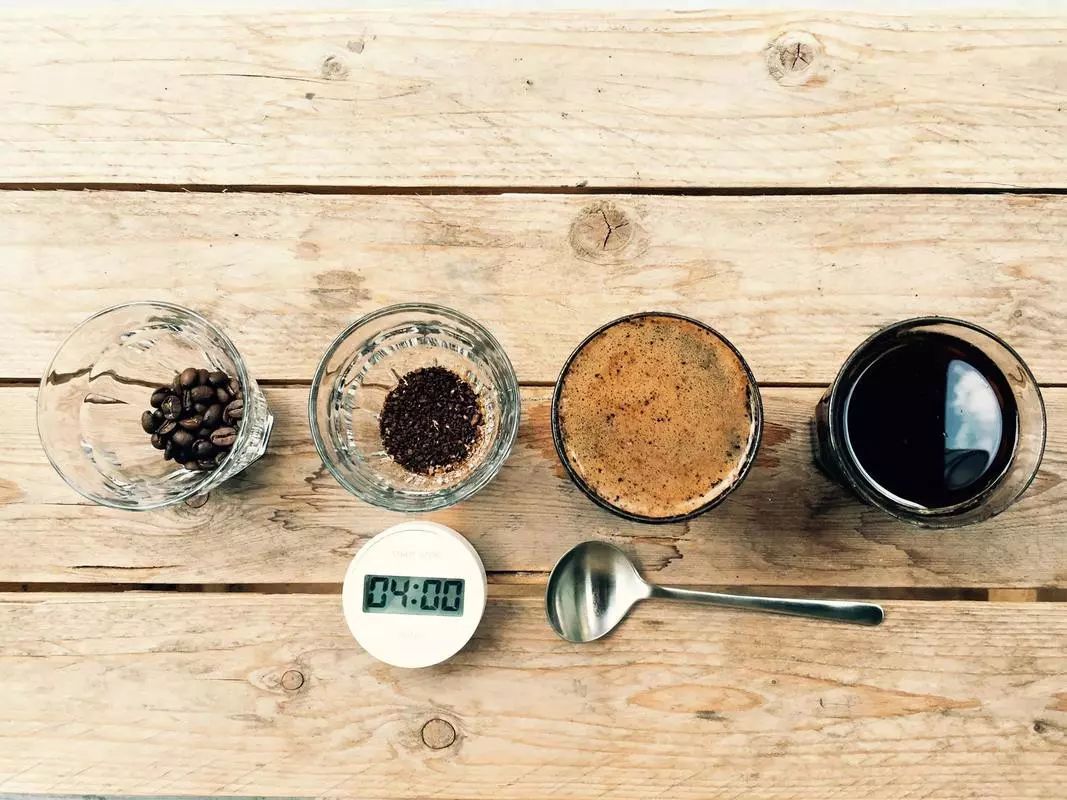
Smell, taste and aftertaste to teach you how to taste coffee
The first step: smell the incense
| start from smelling the aroma
Before the entrance, use your nose to appreciate the aroma of the coffee. Here you can not hesitate to borrow wine tasting words, first smell your coffee to see if it has aroma, such as flower, fruit or wine, whether there is abnormal rotten soil, mildew, volatile sour or spicy taste, these are the taste produced by poor quality or improper preservation of coffee beans. If it is a healthy coffee, then in the aroma can give you a lot of enjoyment. You can not hesitate to use the wine tasting system to evaluate a coffee, looking for fruity, floral, botanical, roasted and spicy aromas. As the heat of coffee helps spread the aroma, you can easily capture the rich and complex aroma of coffee.
Close to the mouth and nose, you will feel the dry aroma of different coffees from different coffee producing areas. For example, in Latin American coffee, you will smell something similar to nuts and dark chocolate, while coffee in Africa has more floral and fruit flavors. Close your eyes and smell its wet fragrance slowly.
Step 2: taste the flavor
| start from smelling the aroma
When coffee is in your mouth, you can feel its flavor. In this respect, many enthusiasts, especially those who are just beginning to come into contact with coffee tasting, always think that coffee doesn't smell good. It is true that the sensory discrimination of coffee liquid in the mouth requires a certain amount of exercise, but over time, the flavor can be detected. Good coffee is tasteless, pure and transparent. Cleanliness refers to the first to the last taste of coffee, without unpleasant miscellaneous taste and taste.
Mellowness is what we usually call boby, which refers to the round, mellow and strong taste of the coffee liquid. The difference between a cup of water and a cup of coffee is that water is tasteless and not sticky, while espresso is rich in oil and has a good thickness. A cup of coffee with a good mellow thickness will make the aroma stay in the mouth longer and the finish longer.
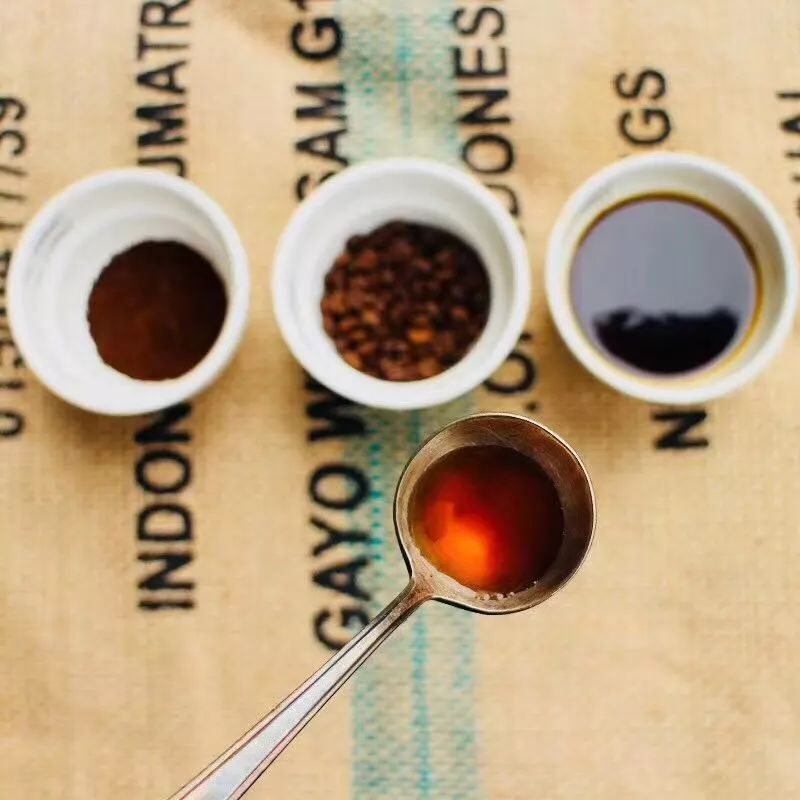
| another key point of coffee tasting is how to distinguish between sweet, salty, sour and bitter coffee.
Why is it sweet?
In fact, there has been a big misunderstanding for a long time. People who like black coffee do not mean that they like bitter taste, and bitterness is not the main flavor of normal black coffee. If the coffee berries are fully ripe, roasted and maintained with good freshness, the coffee itself will have a certain sweet taste, especially the aroma of caramel, honey and even sucrose. At the same time, many kinds of coffee itself have a good round texture. These exquisite features worth appreciating can be obliterated by a small spoonful of sugar and milk. Of course, if it's just mediocre quality, or coffee that has been stored for too long, you will simply have a problem with yourself without milk and sugar.
How can it be salty?
Many people can drink the ups and downs of coffee, but there is another flavor "salty" that is often overlooked. These four flavors influence and restrain each other, while Xianxian is good at hiding under the cover of the other three flavors.
The salty taste of coffee mainly comes from water-soluble minerals. Such as potassium oxide, sodium oxide and so on, as well as the growing environment, baking degree, freshness of coffee beans, treatment (such as the Indian monsoon) and cooking methods and other factors will affect the degree of saltiness.
Also, the concentration, or the acidity and basicity of the water, can make a cup of coffee salty.
Why does it taste sour?
For those who often drink individual coffee, when it comes to sour coffee, most of them will think of Yejia Xuefei, which is indeed the representative of acidic coffee. Beginner friends who have not come into contact with individual coffee may wonder why the coffee is sour. If the coffee is sour, is it a bad coffee that has expired? In fact, this acid is not the other acid, coffee contains hundreds of acidic compounds.
Coffee is the seed of fruit, of course, there is a certain amount of acid. Like [citric acid], [malic acid], citric acid is an important organic acid. Citric acid reaches its peak in shallow baking and is constantly decomposed and destroyed in the later stage of baking. Usually domestic bakers to Yega, Rosa, Kenya are all shallow baking, so it tastes sour.
The acidity of high-quality coffee has a unique aroma, giving the coffee soul; on the contrary, the acid of cheap coffee lacks aroma and even has a strange smell, so the roaster naturally has to remove the acidity. The right acid can increase the activity, brightness and fruit flavor of coffee.
Where's the bitterness?
Take a sip gently, if there is a bitter taste, it will affect the level of the whole cup of coffee, the negative astringent taste will expose the defects in the coffee quality, but if the bitterness can return to the sweet, astringent can give birth to Jin, the high-quality bitter taste is sometimes a symbol of the quality of coffee.
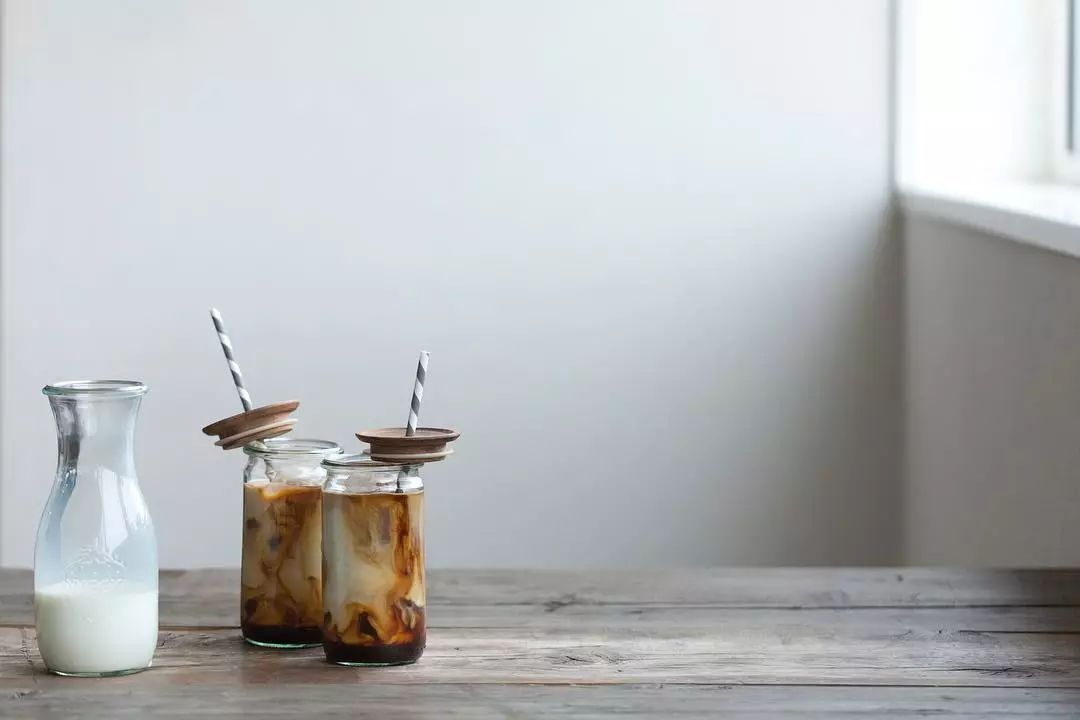
The third step is to perceive the aftertaste
The last point of tasting is Huigan. The so-called Huigan refers to the aftertaste of coffee in the mouth and throat. After drinking the coffee, there will always be a taste back from the throat, some of the aftertaste is very long and clear, some are very short and very vague. We say that a longer and clearer aftertaste is good, and the coffee is of higher quality.
| | throat rhyme is generally divided into sweet, moist, dry and cool |
Gan, that is, the feeling of returning to the throat.
As opposed to dryness, moisten the throat with a sense of comfort and smoothness, while dryness makes the throat uncomfortable, producing a dry and dry feeling, and even makes it difficult to swallow. In addition to extremely uncomfortable throat, dryness will also make drinkers anxious.
The cool throat rhyme is the best feeling, just like the coolness brought by drinking mint water.
Next, when you pick up a cup of coffee and bring it to your mouth to taste it, whether you consciously explore the olfactory performance of this cup of coffee or not, the smell of this cup of coffee has penetrated into your nasal passage. and recorded by your brain.
Learning to taste coffee is a long process. Beginners should not be frustrated by temporary difficulties. Get in touch with coffee more, taste coffee more, and taste coffee with three steps: smell, taste and aftertaste. Slowly you will find the wonders of coffee flavor.
Important Notice :
前街咖啡 FrontStreet Coffee has moved to new addredd:
FrontStreet Coffee Address: 315,Donghua East Road,GuangZhou
Tel:020 38364473
- Prev

I have a bad stomach. can I have coffee? Research: you have to pick the right coffee beans
Professional coffee knowledge exchange more coffee bean information Please follow the coffee workshop (Wechat official account cafe_style) many people have to have a cup of coffee in the morning to wake up, but coffee is not available to everyone, some people like it because of a bad stomach, as long as they drink coffee will cause discomfort, and finally have to give up drinking coffee, but now there are research results show that you may only
- Next

Coffee Taste | how to identify lemon, grapefruit and honey in coffee?
Professional coffee knowledge exchange more coffee bean information Please follow the coffee workshop (Wechat official account cafe_style) when we taste coffee, it is easy to confuse the concepts of taste, flavor and aroma. In fact, the words taste, taste and aroma cannot be accurately interchangeable, but it is very simple to distinguish the difference between them. To put it simply: taste
Related
- How did the Salvadoran coffee industry develop in Central America?
- What exactly does the golden cup extraction of coffee mean?
- The Origin of Coffee flower
- [2023 Starbucks World Earth Day] there are more meaningful things besides free Starbucks coffee!
- What kind of coffee is there in Spain? 9 Flavors of Spanish Coffee
- Aromatic African coffee| Kenya's coffee culture and historical production area
- Liberica Coffee Bean knowledge: the characteristics of Liberian Coffee beans of the three original species of Coffee beans
- The origin and formula of Spanish latte introduces the taste characteristics of Bombon coffee in Valencia, Spain.
- How to adjust the solution of over-extracted coffee
- What is the tasting period of coffee beans? What is the period of coffee and beans? How should coffee wake up and raise beans?

